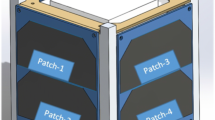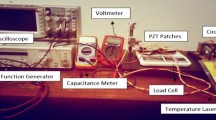Abstract
Piezoelectric materials are widely used as smart structures in cubic reconnaissance satellites because of their sensing, actuating, and energy-harvesting abilities. In this study, an analytical model is developed in specific mechanical thermal shocking conditions. A special circuit and apparatus is designed for experimentation on the basis of the inverse piezoelectric effect. An equivalent circuit method is used to establish the relationship between the resistance and peak-to-peak voltage of lead zirconate titanate used as smart materials for cubic reconnaissance satellites. Various frequencies and resistance were applied in different mechanical thermal shocking conditions. Moreover, numerical simulations are conducted in various mechanical loading conditions to determine the accumulative effect. The model provides a novel mechanism to characterize the smart structures in cubic reconnaissance satellites. A rise in temperature increases peak-to-peak voltage; a rise in frequency decreases peak-to-peak voltage; and intensified resistance decreases peak-to-peak voltage. Based on experimentation and simulation, the optimum resistance is predicted for the various frequencies and temperatures. The various conditions may correspond to the different applications of smart structures for cubic reconnaissance satellites. The analytical calculations are in good agreement with experimental and numerical calculations.
Similar content being viewed by others
Change history
26 February 2019
There is one correction to make to the original article.
References
A. K. Noor et al., Structures technology for future aerospace systems, Computers & Structures, 74 (5) (2000) 507–519.
P. Gaudenzi, Smart structures: Physical behaviour, mathematical modelling and applications, John Wiley & Sons (2009).
V. G. M. Annamdas and C. K. Soh, Contactless load monitoring in near-field with surface localized spoof plasmons— A new breed of metamaterials for health of engineering structures, Sensors and Actuators A: Physical, 244 (2016) 156–165.
Q. Lei et al., Design and experiment of PZT network-based structural health monitoring scanning system, Chinese Journal of Aeronautics, 22 (5) (2009) 505–512.
D. Vasic, Y.-Y. Chen and F. Costa, Self-powered piezoelectric energy harvester for bicycle, Journal of Mechanical Science and Technology, 28 (7) (2014) 2501–2510.
P. Gasbarri, R. Monti and M. Sabatini, Very large space structures: Non-linear control and robustness to structural uncertainties, Acta Astronautica, 93 (2014) 252–265.
P. Gasbarri et al., Effects of uncertainties and flexible dynamic contributions on the control of a spacecraft fullcoupled model, Acta Astronautica, 94 (1) (2014) 515–526.
N. R. Fisco and H. Adeli, Smart structures: Part I—Active and semi-active control, Scientia Iranica, 18 (3) (2011) 275–284.
M. Kamali et al., Integrated nozzle-flapper valve with piezoelectric actuator and isothermal chamber: A feedback linearization multi control device, Journal of Mechanical Science and Technology, 30 (5) (2016) 2293–2301.
D. Zhengchun et al., Design and application of composite platform with extreme low thermal deformation for satellite, Composite Structures (2016).
J. C. Williams and E. A. Starke, Progress in structural materials for aerospace systems11, The Golden Jubilee Issue— Selected topics in Materials Science and Engineering: Past, Present and Future, Edited by S. Suresh, Acta Materialia, 51 (19) (2003) 5775–5799.
J. Fialka et al., Measurement of thermal depolarization effects in piezoelectric coefficients of soft PZT ceramics via the frequency and direct methods, Journal of the European Ceramic Society, 36 (11) (2016) 2727–2738.
H. Madinei et al., Design of MEMS piezoelectric harvesters with electrostatically adjustable resonance frequency, Mechanical Systems and Signal Processing, 81 (2016) 360–374.
S. Azizi et al., A conceptual study on the dynamics of a piezoelectric MEMS (Micro Electro Mechanical System) energy harvester, Energy, 96 (2016) 495–506.
H.-H. Huang and K.-S. Chen, Design, analysis, and experimental studies of a novel PVDF-based piezoelectric energy harvester with beating mechanisms, Sensors and Actuators A: Physical, 238 (2016) 317–328.
S.-C. Huang and C.-Y. Tsai, Theoretical analysis of a new adjustable broadband PZT beam vibration energy harvester, International Journal of Mechanical Sciences, 105 (2016) 304–314.
S. Porn et al., Level set based structural optimization of distributed piezoelectric modal sensors for plate structures, International Journal of Solids and Structures, 80 (2016) 348–358.
H. Elahi et al., Robust vehicle suspension system by converting active & passive control of a vehicle to semi-active control system analytically, Journal of Automation and Control Engineering, 4 (4) (2016).
S. Waqar et al., Effect of drilling parameters on hole quality of Ti-6Al-4V titanium alloy in dry drilling, Materials Science Forum, Trans Tech Publications (2017).
S. Riaz et al., Vibration feature extraction and analysis for fault diagnosis of rotating machinery-A literature survey, Asia Pacific Journal of Multidisciplinary Research, 5 (1) (2017).
M. A. Gull, H. Elahi, M. Marwat and S. Waqar, A new approach to classification of upper limb and wrist movements using EEG signals, 2017 13th IASTED International Conference on Biomedical Engineering (BioMed), IEEE (2017) 181–194.
A. S. Belward and J. O. Skøien, Who launched what, when and why; trends in global land-cover observation capacity from civilian earth observation satellites, ISPRS Journal of Photogrammetry and Remote Sensing, 103 (2015) 115–128.
D. P. Roy et al., Landsat-8: Science and product vision for terrestrial global change research, Remote Sensing of Environment, 145 (2014) 154–172.
L. Olivieri and A. Francesconi, Design and test of a semiandrogynous docking mechanism for small satellites, Acta Astronautica, 122 (2016) 219–230.
N. Bérend and X. Olive, Bi-objective optimization of a multiple-target active debris removal mission, Acta Astronautica, 122 (2016) 324–335.
H. Elahi, R. Pasha and M. Khan, Experimental determination of mechanical quality factor of lead zirconate titanate (PZT-5A4E) by equivalent circuit method under various thermal and resistance conditions, University of Engineering and Technology Taxila, Technical Journal, 19 (2) (2014) 1.
P. Liu et al., Transient thermal shock fracture analysis of functionally graded piezoelectric materials by the extended finite element method, International Journal of Solids and Structures, 51 (11–12) (2014) 2167–2182.
J. Boughaleb et al., Design and performance benchmark of various architectures of a piezoelectric bimetallic strip heat engine, Optical Materials, 56 (2016) 110–115.
G. G. Sheng and X. Wang, Response and control of functionally graded laminated piezoelectric shells under thermal shock and moving loadings, Composite Structures, 93 (1) (2010) 132–141.
S. S. Vel and B. P. Baillargeon, Analysis of static deformation, vibration and active damping of cylindrical composite shells with piezoelectric shear actuators, Journal of Vibration and Acoustics, 127 (4) (2005) 395.
J. Sladek et al., Fracture analysis in piezoelectric semiconductors under a thermal load, Engineering Fracture Mechanics, 126 (2014) 27–39.
Z. Butt, R. A. Pasha, F. Qayyum, Z. Anjum, N. Ahmad and H. Elahi, Generation of electrical energy using lead zirconate titanate (PZT-5A) piezoelectric material: Analytical, numerical and experimental verifications, Journal of Mechanical Science and Technology, 30 (2016) 3553–3558.
Author information
Authors and Affiliations
Corresponding author
Additional information
Recommended by Associate Editor Sang-Hee Yoon
Hassan Elahi is currently enrolled for Ph.D. in Aerospace and Satellite Engineering at La Sapienza University of Rome, Italy. He is also working as a Lecturer at Institute of Space Technology, Islamabad, Pakistan. He has done his Masters of Science by research in Applied Mechanics and Design with Award of Honors in 2014. He worked on Mechanical Quality Factor of Piezoelectric Material. His research interest includes MEMs, Applied Mechanics and Design, Control Engineering and Electro-mechanics.
Rights and permissions
About this article
Cite this article
Elahi, H., Butt, Z., Eugnei, M. et al. Effects of variable resistance on smart structures of cubic reconnaissance satellites in various thermal and frequency shocking conditions. J Mech Sci Technol 31, 4151–4157 (2017). https://doi.org/10.1007/s12206-017-0811-z
Received:
Revised:
Accepted:
Published:
Issue Date:
DOI: https://doi.org/10.1007/s12206-017-0811-z




